Analysis of Management Accounting: London Beer Factory Report
VerifiedAdded on 2023/01/18
|16
|4315
|99
Report
AI Summary
This report provides a comprehensive analysis of management accounting practices, focusing on the London Beer Factory as a case study. It begins with an introduction to management accounting and its significance, followed by an examination of various management accounting systems such as cost accounting, price optimization, inventory management, and job costing. The report then delves into different types of management accounting reports, including cost reports, stock reports, and accounts receivable reports, highlighting their benefits and integration within organizational processes. Furthermore, the report explores financial statement preparation using marginal and absorption costing methods, presenting income statements and their interpretations. Finally, it discusses the limitations and benefits of planning tools for budgetary control, providing a well-rounded overview of management accounting principles and applications.
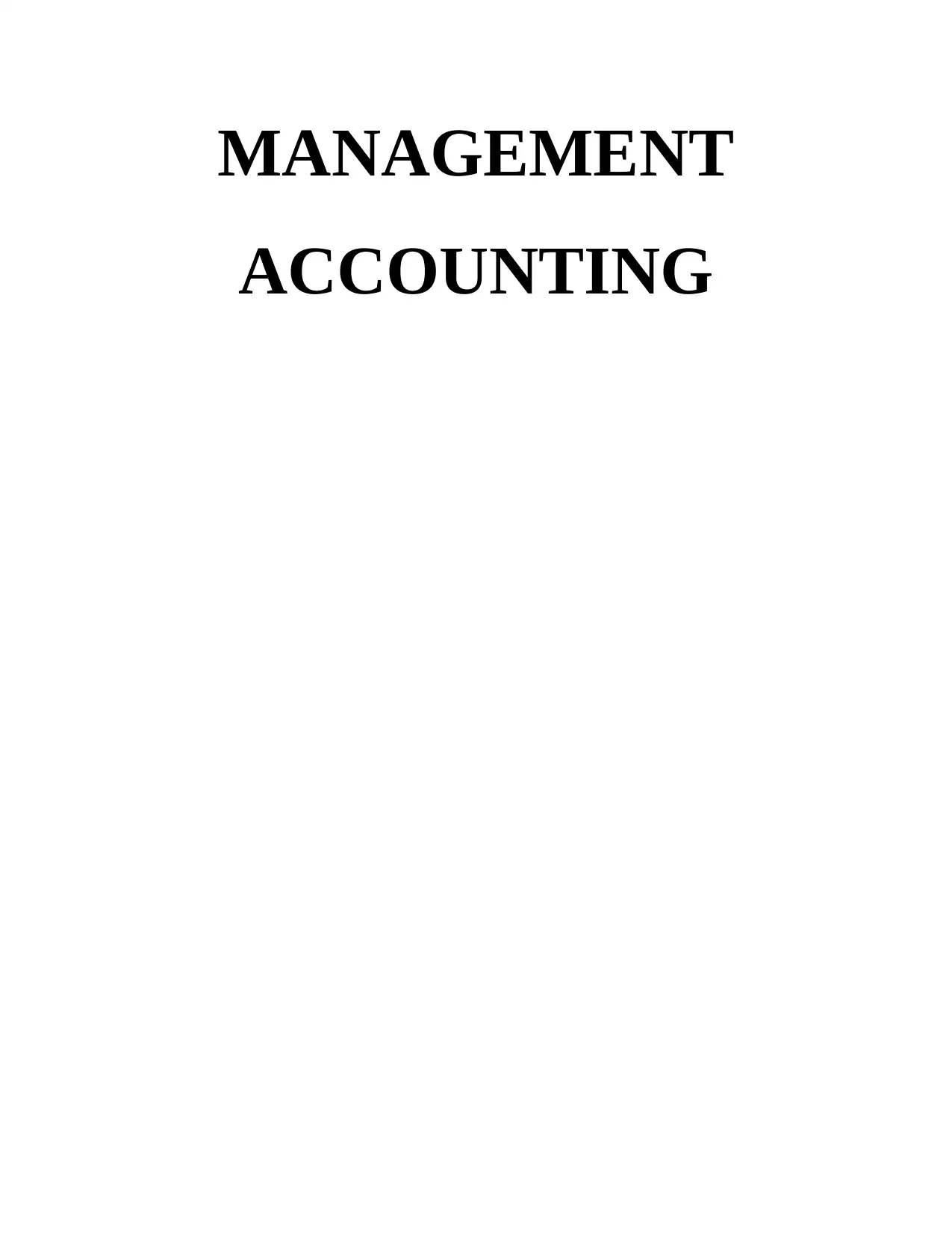
MANAGEMENT
ACCOUNTING
ACCOUNTING
Paraphrase This Document
Need a fresh take? Get an instant paraphrase of this document with our AI Paraphraser
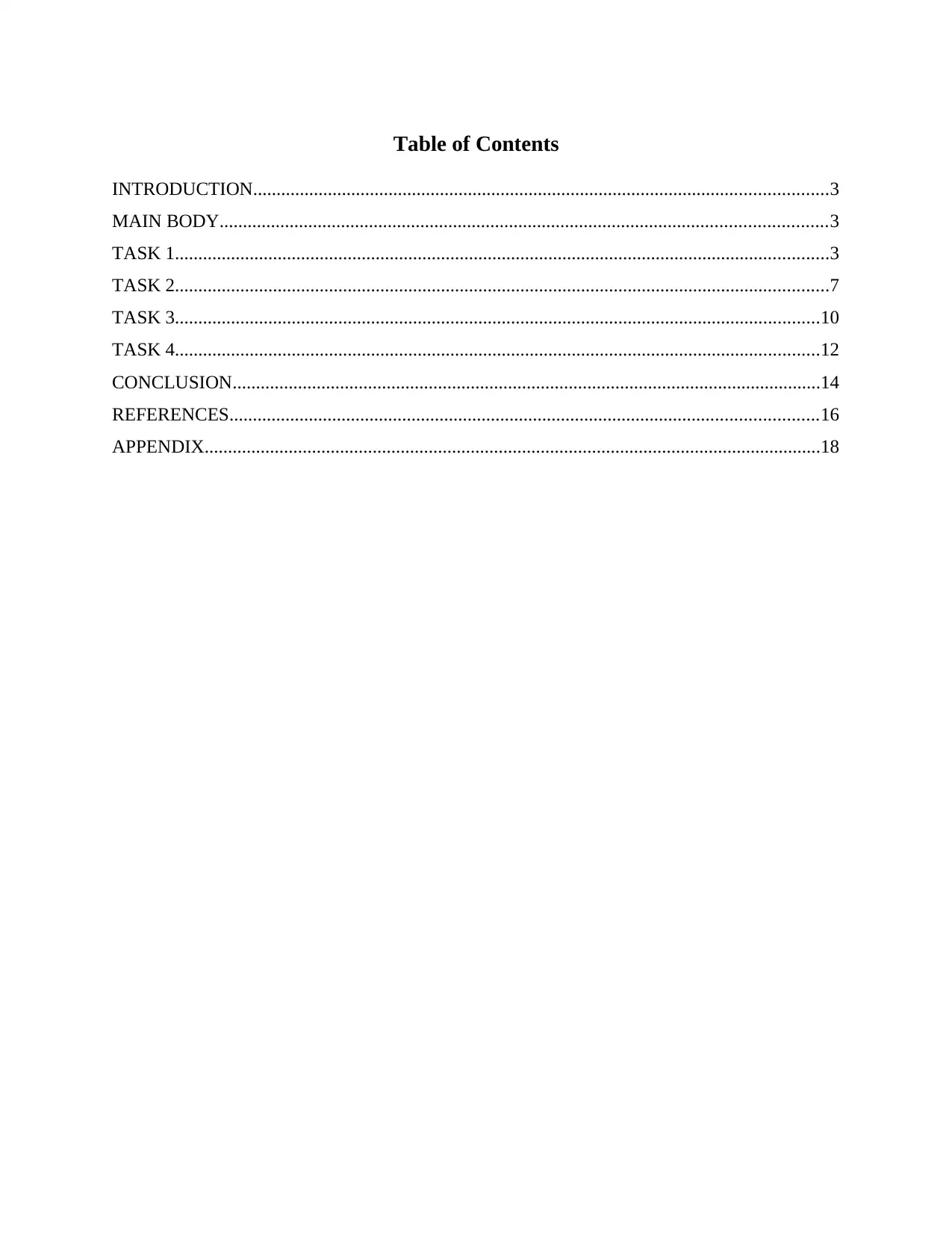
Table of Contents
INTRODUCTION...........................................................................................................................3
MAIN BODY..................................................................................................................................3
TASK 1............................................................................................................................................3
TASK 2............................................................................................................................................7
TASK 3..........................................................................................................................................10
TASK 4..........................................................................................................................................12
CONCLUSION..............................................................................................................................14
REFERENCES..............................................................................................................................16
APPENDIX....................................................................................................................................18
INTRODUCTION...........................................................................................................................3
MAIN BODY..................................................................................................................................3
TASK 1............................................................................................................................................3
TASK 2............................................................................................................................................7
TASK 3..........................................................................................................................................10
TASK 4..........................................................................................................................................12
CONCLUSION..............................................................................................................................14
REFERENCES..............................................................................................................................16
APPENDIX....................................................................................................................................18
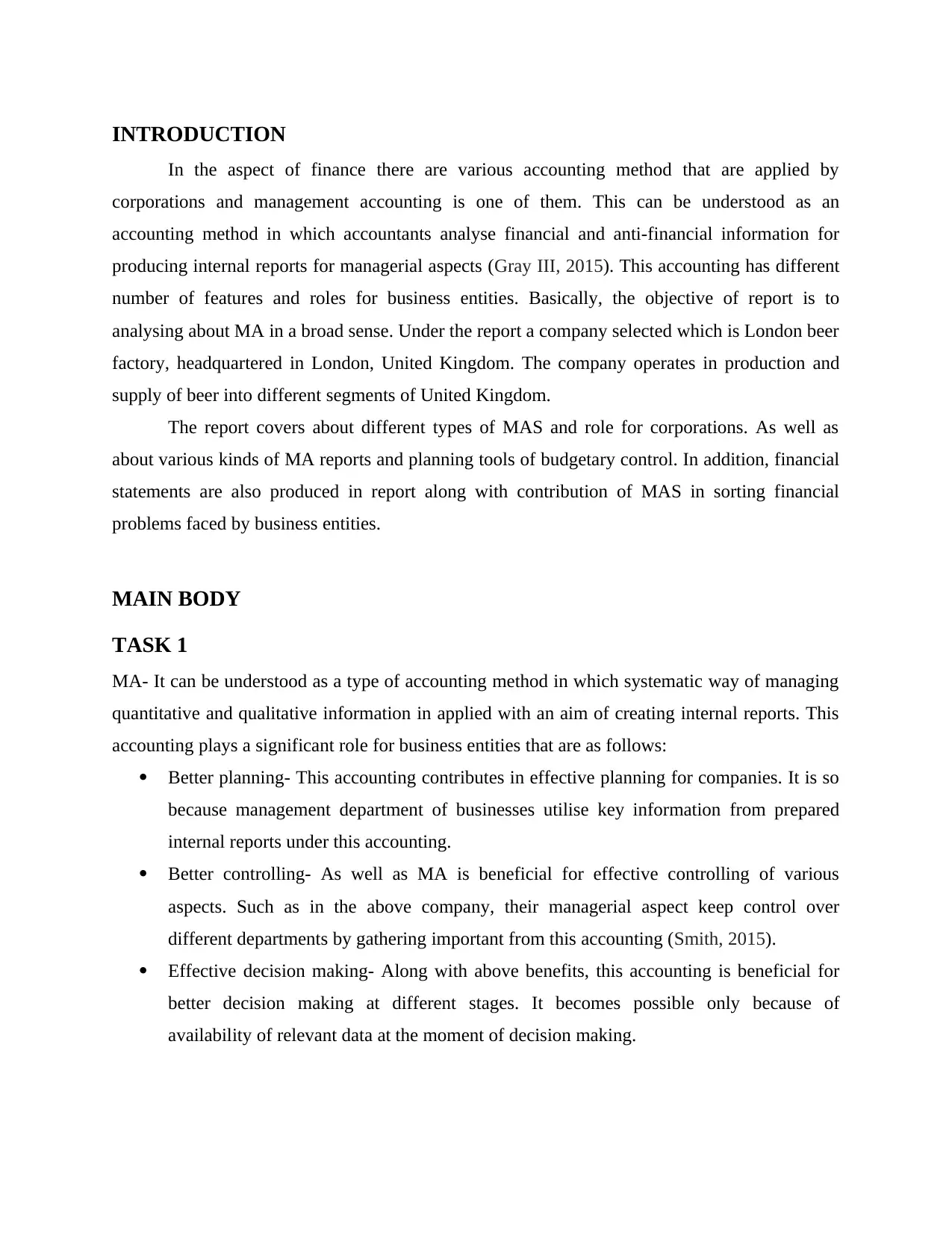
INTRODUCTION
In the aspect of finance there are various accounting method that are applied by
corporations and management accounting is one of them. This can be understood as an
accounting method in which accountants analyse financial and anti-financial information for
producing internal reports for managerial aspects (Gray III, 2015). This accounting has different
number of features and roles for business entities. Basically, the objective of report is to
analysing about MA in a broad sense. Under the report a company selected which is London beer
factory, headquartered in London, United Kingdom. The company operates in production and
supply of beer into different segments of United Kingdom.
The report covers about different types of MAS and role for corporations. As well as
about various kinds of MA reports and planning tools of budgetary control. In addition, financial
statements are also produced in report along with contribution of MAS in sorting financial
problems faced by business entities.
MAIN BODY
TASK 1
MA- It can be understood as a type of accounting method in which systematic way of managing
quantitative and qualitative information in applied with an aim of creating internal reports. This
accounting plays a significant role for business entities that are as follows:
Better planning- This accounting contributes in effective planning for companies. It is so
because management department of businesses utilise key information from prepared
internal reports under this accounting.
Better controlling- As well as MA is beneficial for effective controlling of various
aspects. Such as in the above company, their managerial aspect keep control over
different departments by gathering important from this accounting (Smith, 2015).
Effective decision making- Along with above benefits, this accounting is beneficial for
better decision making at different stages. It becomes possible only because of
availability of relevant data at the moment of decision making.
In the aspect of finance there are various accounting method that are applied by
corporations and management accounting is one of them. This can be understood as an
accounting method in which accountants analyse financial and anti-financial information for
producing internal reports for managerial aspects (Gray III, 2015). This accounting has different
number of features and roles for business entities. Basically, the objective of report is to
analysing about MA in a broad sense. Under the report a company selected which is London beer
factory, headquartered in London, United Kingdom. The company operates in production and
supply of beer into different segments of United Kingdom.
The report covers about different types of MAS and role for corporations. As well as
about various kinds of MA reports and planning tools of budgetary control. In addition, financial
statements are also produced in report along with contribution of MAS in sorting financial
problems faced by business entities.
MAIN BODY
TASK 1
MA- It can be understood as a type of accounting method in which systematic way of managing
quantitative and qualitative information in applied with an aim of creating internal reports. This
accounting plays a significant role for business entities that are as follows:
Better planning- This accounting contributes in effective planning for companies. It is so
because management department of businesses utilise key information from prepared
internal reports under this accounting.
Better controlling- As well as MA is beneficial for effective controlling of various
aspects. Such as in the above company, their managerial aspect keep control over
different departments by gathering important from this accounting (Smith, 2015).
Effective decision making- Along with above benefits, this accounting is beneficial for
better decision making at different stages. It becomes possible only because of
availability of relevant data at the moment of decision making.
⊘ This is a preview!⊘
Do you want full access?
Subscribe today to unlock all pages.

Trusted by 1+ million students worldwide
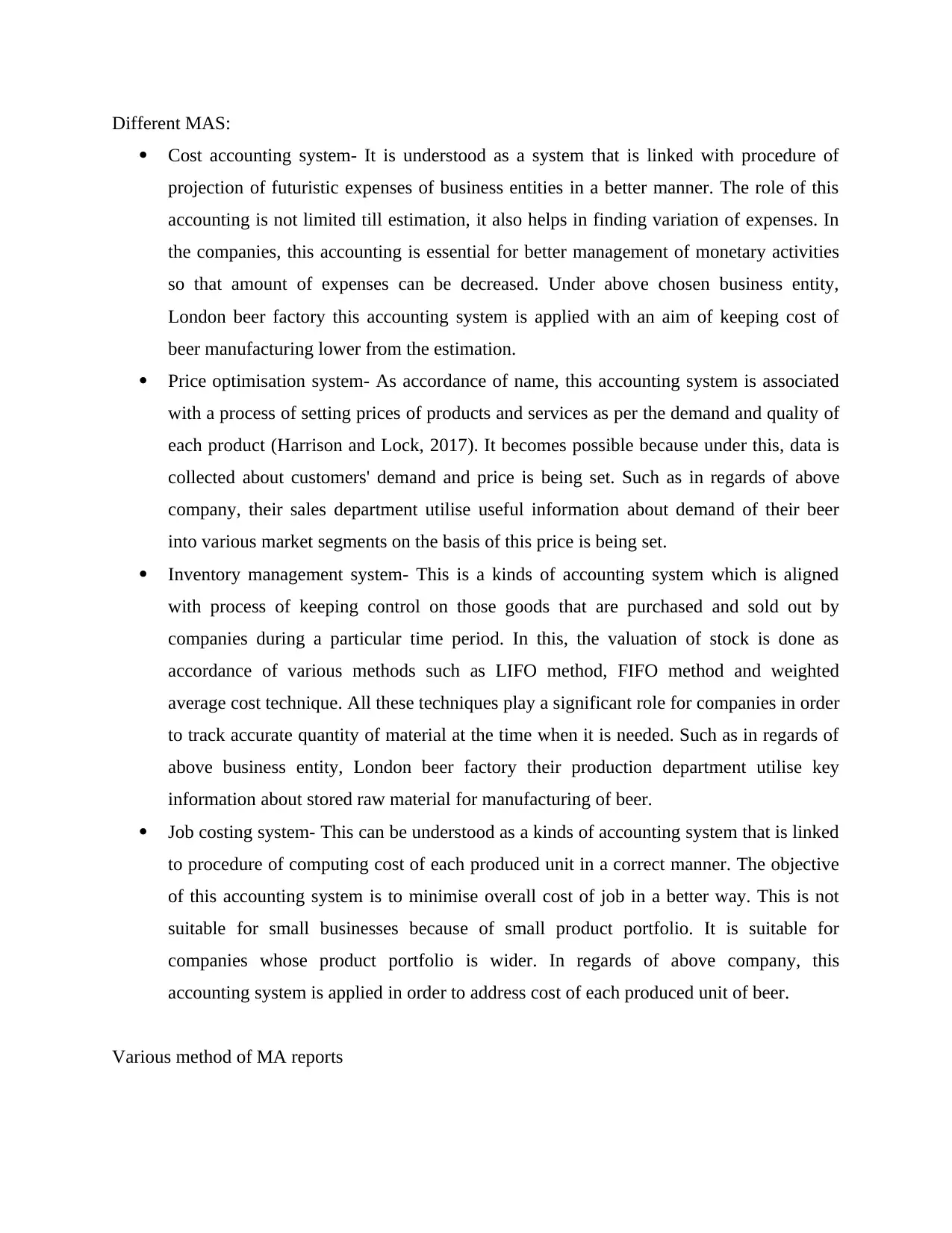
Different MAS:
Cost accounting system- It is understood as a system that is linked with procedure of
projection of futuristic expenses of business entities in a better manner. The role of this
accounting is not limited till estimation, it also helps in finding variation of expenses. In
the companies, this accounting is essential for better management of monetary activities
so that amount of expenses can be decreased. Under above chosen business entity,
London beer factory this accounting system is applied with an aim of keeping cost of
beer manufacturing lower from the estimation.
Price optimisation system- As accordance of name, this accounting system is associated
with a process of setting prices of products and services as per the demand and quality of
each product (Harrison and Lock, 2017). It becomes possible because under this, data is
collected about customers' demand and price is being set. Such as in regards of above
company, their sales department utilise useful information about demand of their beer
into various market segments on the basis of this price is being set.
Inventory management system- This is a kinds of accounting system which is aligned
with process of keeping control on those goods that are purchased and sold out by
companies during a particular time period. In this, the valuation of stock is done as
accordance of various methods such as LIFO method, FIFO method and weighted
average cost technique. All these techniques play a significant role for companies in order
to track accurate quantity of material at the time when it is needed. Such as in regards of
above business entity, London beer factory their production department utilise key
information about stored raw material for manufacturing of beer.
Job costing system- This can be understood as a kinds of accounting system that is linked
to procedure of computing cost of each produced unit in a correct manner. The objective
of this accounting system is to minimise overall cost of job in a better way. This is not
suitable for small businesses because of small product portfolio. It is suitable for
companies whose product portfolio is wider. In regards of above company, this
accounting system is applied in order to address cost of each produced unit of beer.
Various method of MA reports
Cost accounting system- It is understood as a system that is linked with procedure of
projection of futuristic expenses of business entities in a better manner. The role of this
accounting is not limited till estimation, it also helps in finding variation of expenses. In
the companies, this accounting is essential for better management of monetary activities
so that amount of expenses can be decreased. Under above chosen business entity,
London beer factory this accounting system is applied with an aim of keeping cost of
beer manufacturing lower from the estimation.
Price optimisation system- As accordance of name, this accounting system is associated
with a process of setting prices of products and services as per the demand and quality of
each product (Harrison and Lock, 2017). It becomes possible because under this, data is
collected about customers' demand and price is being set. Such as in regards of above
company, their sales department utilise useful information about demand of their beer
into various market segments on the basis of this price is being set.
Inventory management system- This is a kinds of accounting system which is aligned
with process of keeping control on those goods that are purchased and sold out by
companies during a particular time period. In this, the valuation of stock is done as
accordance of various methods such as LIFO method, FIFO method and weighted
average cost technique. All these techniques play a significant role for companies in order
to track accurate quantity of material at the time when it is needed. Such as in regards of
above business entity, London beer factory their production department utilise key
information about stored raw material for manufacturing of beer.
Job costing system- This can be understood as a kinds of accounting system that is linked
to procedure of computing cost of each produced unit in a correct manner. The objective
of this accounting system is to minimise overall cost of job in a better way. This is not
suitable for small businesses because of small product portfolio. It is suitable for
companies whose product portfolio is wider. In regards of above company, this
accounting system is applied in order to address cost of each produced unit of beer.
Various method of MA reports
Paraphrase This Document
Need a fresh take? Get an instant paraphrase of this document with our AI Paraphraser
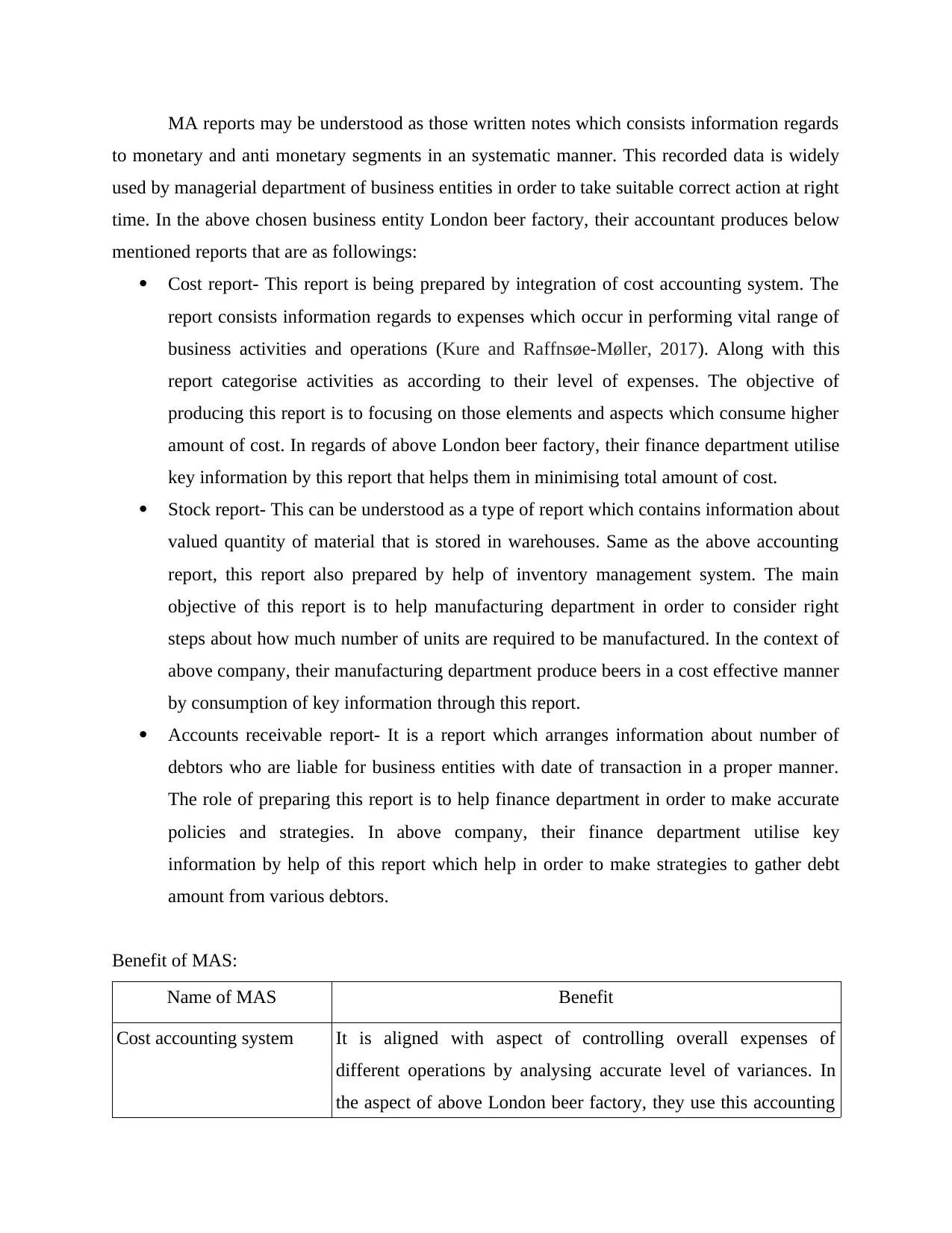
MA reports may be understood as those written notes which consists information regards
to monetary and anti monetary segments in an systematic manner. This recorded data is widely
used by managerial department of business entities in order to take suitable correct action at right
time. In the above chosen business entity London beer factory, their accountant produces below
mentioned reports that are as followings:
Cost report- This report is being prepared by integration of cost accounting system. The
report consists information regards to expenses which occur in performing vital range of
business activities and operations (Kure and Raffnsøe-Møller, 2017). Along with this
report categorise activities as according to their level of expenses. The objective of
producing this report is to focusing on those elements and aspects which consume higher
amount of cost. In regards of above London beer factory, their finance department utilise
key information by this report that helps them in minimising total amount of cost.
Stock report- This can be understood as a type of report which contains information about
valued quantity of material that is stored in warehouses. Same as the above accounting
report, this report also prepared by help of inventory management system. The main
objective of this report is to help manufacturing department in order to consider right
steps about how much number of units are required to be manufactured. In the context of
above company, their manufacturing department produce beers in a cost effective manner
by consumption of key information through this report.
Accounts receivable report- It is a report which arranges information about number of
debtors who are liable for business entities with date of transaction in a proper manner.
The role of preparing this report is to help finance department in order to make accurate
policies and strategies. In above company, their finance department utilise key
information by help of this report which help in order to make strategies to gather debt
amount from various debtors.
Benefit of MAS:
Name of MAS Benefit
Cost accounting system It is aligned with aspect of controlling overall expenses of
different operations by analysing accurate level of variances. In
the aspect of above London beer factory, they use this accounting
to monetary and anti monetary segments in an systematic manner. This recorded data is widely
used by managerial department of business entities in order to take suitable correct action at right
time. In the above chosen business entity London beer factory, their accountant produces below
mentioned reports that are as followings:
Cost report- This report is being prepared by integration of cost accounting system. The
report consists information regards to expenses which occur in performing vital range of
business activities and operations (Kure and Raffnsøe-Møller, 2017). Along with this
report categorise activities as according to their level of expenses. The objective of
producing this report is to focusing on those elements and aspects which consume higher
amount of cost. In regards of above London beer factory, their finance department utilise
key information by this report that helps them in minimising total amount of cost.
Stock report- This can be understood as a type of report which contains information about
valued quantity of material that is stored in warehouses. Same as the above accounting
report, this report also prepared by help of inventory management system. The main
objective of this report is to help manufacturing department in order to consider right
steps about how much number of units are required to be manufactured. In the context of
above company, their manufacturing department produce beers in a cost effective manner
by consumption of key information through this report.
Accounts receivable report- It is a report which arranges information about number of
debtors who are liable for business entities with date of transaction in a proper manner.
The role of preparing this report is to help finance department in order to make accurate
policies and strategies. In above company, their finance department utilise key
information by help of this report which help in order to make strategies to gather debt
amount from various debtors.
Benefit of MAS:
Name of MAS Benefit
Cost accounting system It is aligned with aspect of controlling overall expenses of
different operations by analysing accurate level of variances. In
the aspect of above London beer factory, they use this accounting
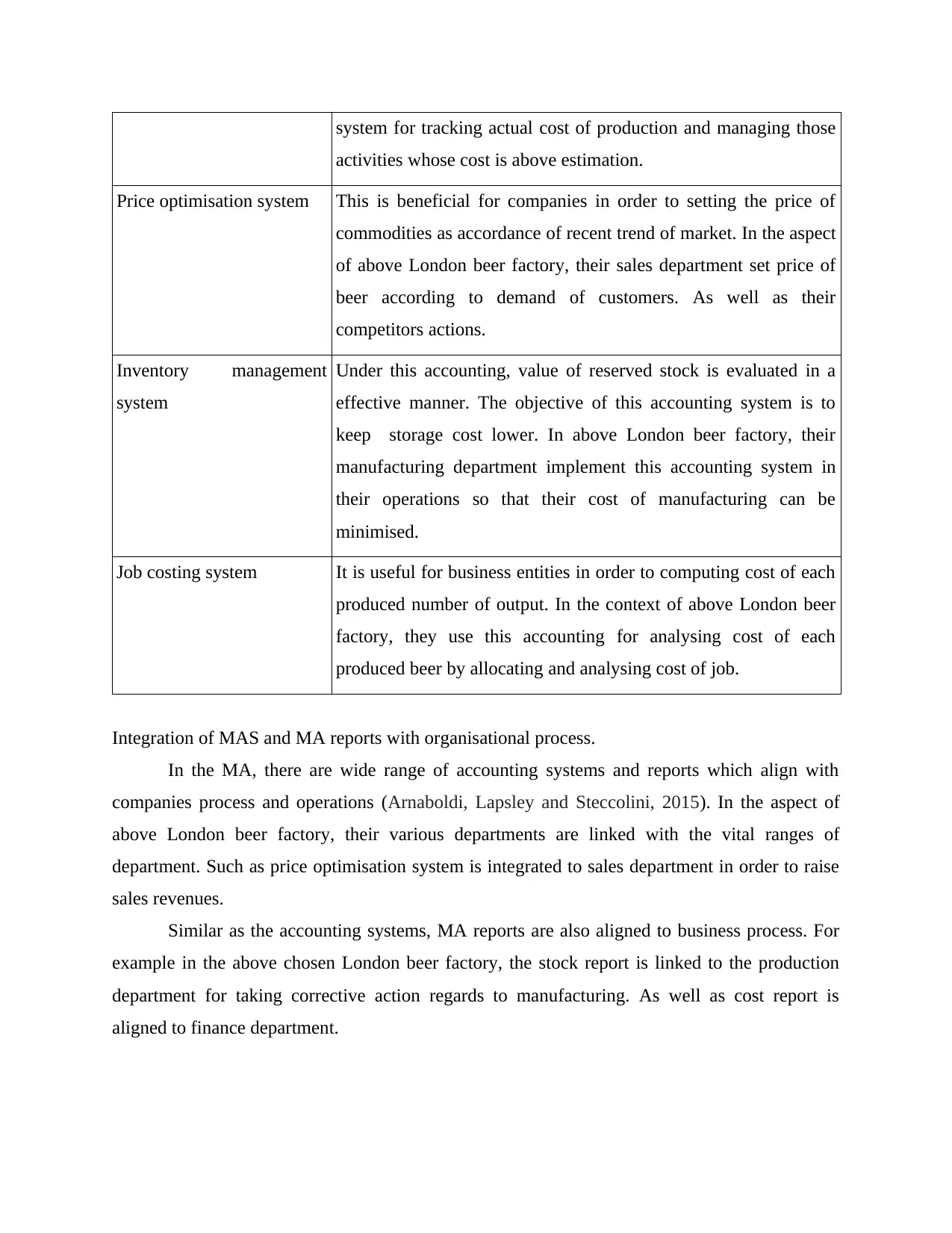
system for tracking actual cost of production and managing those
activities whose cost is above estimation.
Price optimisation system This is beneficial for companies in order to setting the price of
commodities as accordance of recent trend of market. In the aspect
of above London beer factory, their sales department set price of
beer according to demand of customers. As well as their
competitors actions.
Inventory management
system
Under this accounting, value of reserved stock is evaluated in a
effective manner. The objective of this accounting system is to
keep storage cost lower. In above London beer factory, their
manufacturing department implement this accounting system in
their operations so that their cost of manufacturing can be
minimised.
Job costing system It is useful for business entities in order to computing cost of each
produced number of output. In the context of above London beer
factory, they use this accounting for analysing cost of each
produced beer by allocating and analysing cost of job.
Integration of MAS and MA reports with organisational process.
In the MA, there are wide range of accounting systems and reports which align with
companies process and operations (Arnaboldi, Lapsley and Steccolini, 2015). In the aspect of
above London beer factory, their various departments are linked with the vital ranges of
department. Such as price optimisation system is integrated to sales department in order to raise
sales revenues.
Similar as the accounting systems, MA reports are also aligned to business process. For
example in the above chosen London beer factory, the stock report is linked to the production
department for taking corrective action regards to manufacturing. As well as cost report is
aligned to finance department.
activities whose cost is above estimation.
Price optimisation system This is beneficial for companies in order to setting the price of
commodities as accordance of recent trend of market. In the aspect
of above London beer factory, their sales department set price of
beer according to demand of customers. As well as their
competitors actions.
Inventory management
system
Under this accounting, value of reserved stock is evaluated in a
effective manner. The objective of this accounting system is to
keep storage cost lower. In above London beer factory, their
manufacturing department implement this accounting system in
their operations so that their cost of manufacturing can be
minimised.
Job costing system It is useful for business entities in order to computing cost of each
produced number of output. In the context of above London beer
factory, they use this accounting for analysing cost of each
produced beer by allocating and analysing cost of job.
Integration of MAS and MA reports with organisational process.
In the MA, there are wide range of accounting systems and reports which align with
companies process and operations (Arnaboldi, Lapsley and Steccolini, 2015). In the aspect of
above London beer factory, their various departments are linked with the vital ranges of
department. Such as price optimisation system is integrated to sales department in order to raise
sales revenues.
Similar as the accounting systems, MA reports are also aligned to business process. For
example in the above chosen London beer factory, the stock report is linked to the production
department for taking corrective action regards to manufacturing. As well as cost report is
aligned to finance department.
⊘ This is a preview!⊘
Do you want full access?
Subscribe today to unlock all pages.

Trusted by 1+ million students worldwide
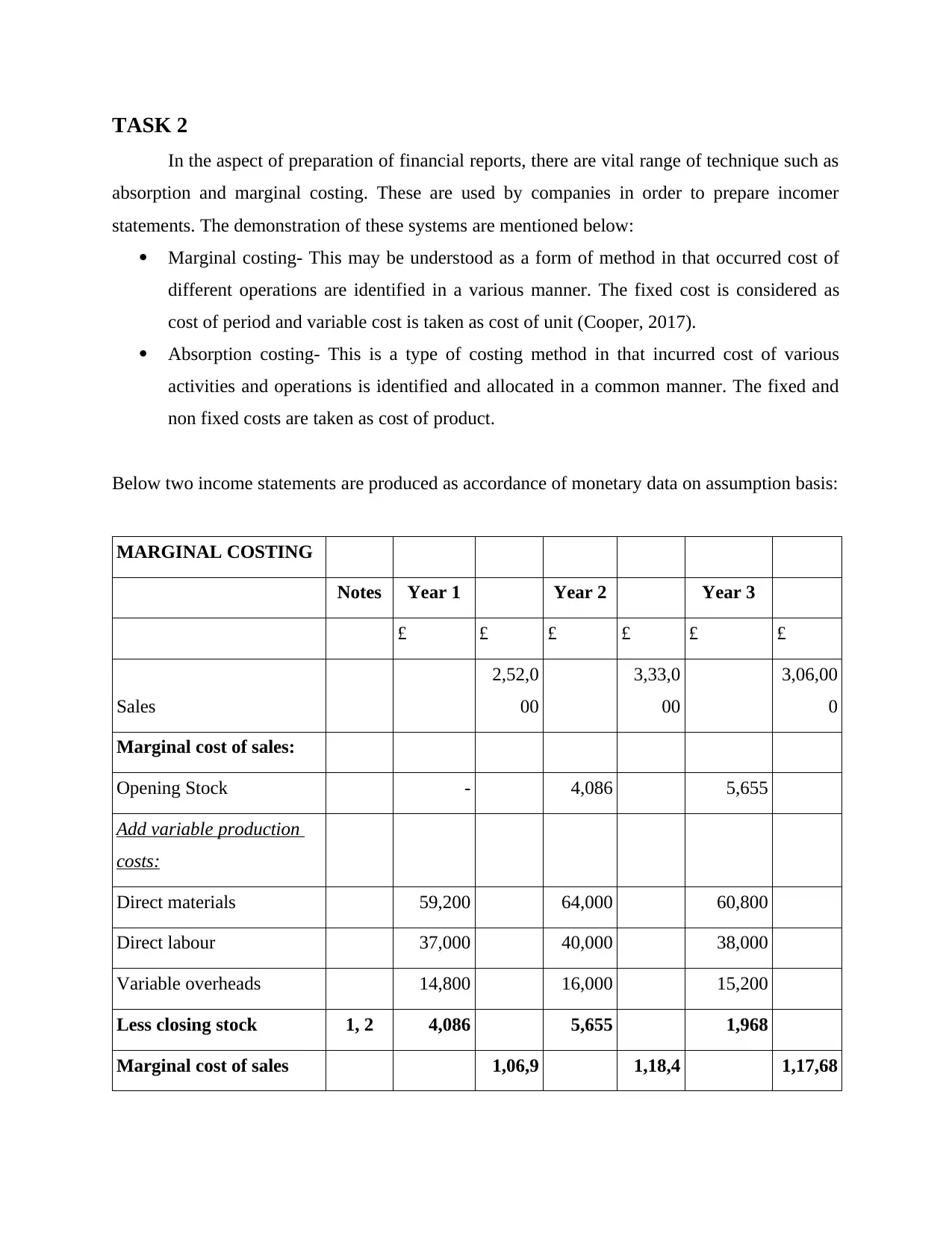
TASK 2
In the aspect of preparation of financial reports, there are vital range of technique such as
absorption and marginal costing. These are used by companies in order to prepare incomer
statements. The demonstration of these systems are mentioned below:
Marginal costing- This may be understood as a form of method in that occurred cost of
different operations are identified in a various manner. The fixed cost is considered as
cost of period and variable cost is taken as cost of unit (Cooper, 2017).
Absorption costing- This is a type of costing method in that incurred cost of various
activities and operations is identified and allocated in a common manner. The fixed and
non fixed costs are taken as cost of product.
Below two income statements are produced as accordance of monetary data on assumption basis:
MARGINAL COSTING
Notes Year 1 Year 2 Year 3
£ £ £ £ £ £
Sales
2,52,0
00
3,33,0
00
3,06,00
0
Marginal cost of sales:
Opening Stock - 4,086 5,655
Add variable production
costs:
Direct materials 59,200 64,000 60,800
Direct labour 37,000 40,000 38,000
Variable overheads 14,800 16,000 15,200
Less closing stock 1, 2 4,086 5,655 1,968
Marginal cost of sales 1,06,9 1,18,4 1,17,68
In the aspect of preparation of financial reports, there are vital range of technique such as
absorption and marginal costing. These are used by companies in order to prepare incomer
statements. The demonstration of these systems are mentioned below:
Marginal costing- This may be understood as a form of method in that occurred cost of
different operations are identified in a various manner. The fixed cost is considered as
cost of period and variable cost is taken as cost of unit (Cooper, 2017).
Absorption costing- This is a type of costing method in that incurred cost of various
activities and operations is identified and allocated in a common manner. The fixed and
non fixed costs are taken as cost of product.
Below two income statements are produced as accordance of monetary data on assumption basis:
MARGINAL COSTING
Notes Year 1 Year 2 Year 3
£ £ £ £ £ £
Sales
2,52,0
00
3,33,0
00
3,06,00
0
Marginal cost of sales:
Opening Stock - 4,086 5,655
Add variable production
costs:
Direct materials 59,200 64,000 60,800
Direct labour 37,000 40,000 38,000
Variable overheads 14,800 16,000 15,200
Less closing stock 1, 2 4,086 5,655 1,968
Marginal cost of sales 1,06,9 1,18,4 1,17,68
Paraphrase This Document
Need a fresh take? Get an instant paraphrase of this document with our AI Paraphraser
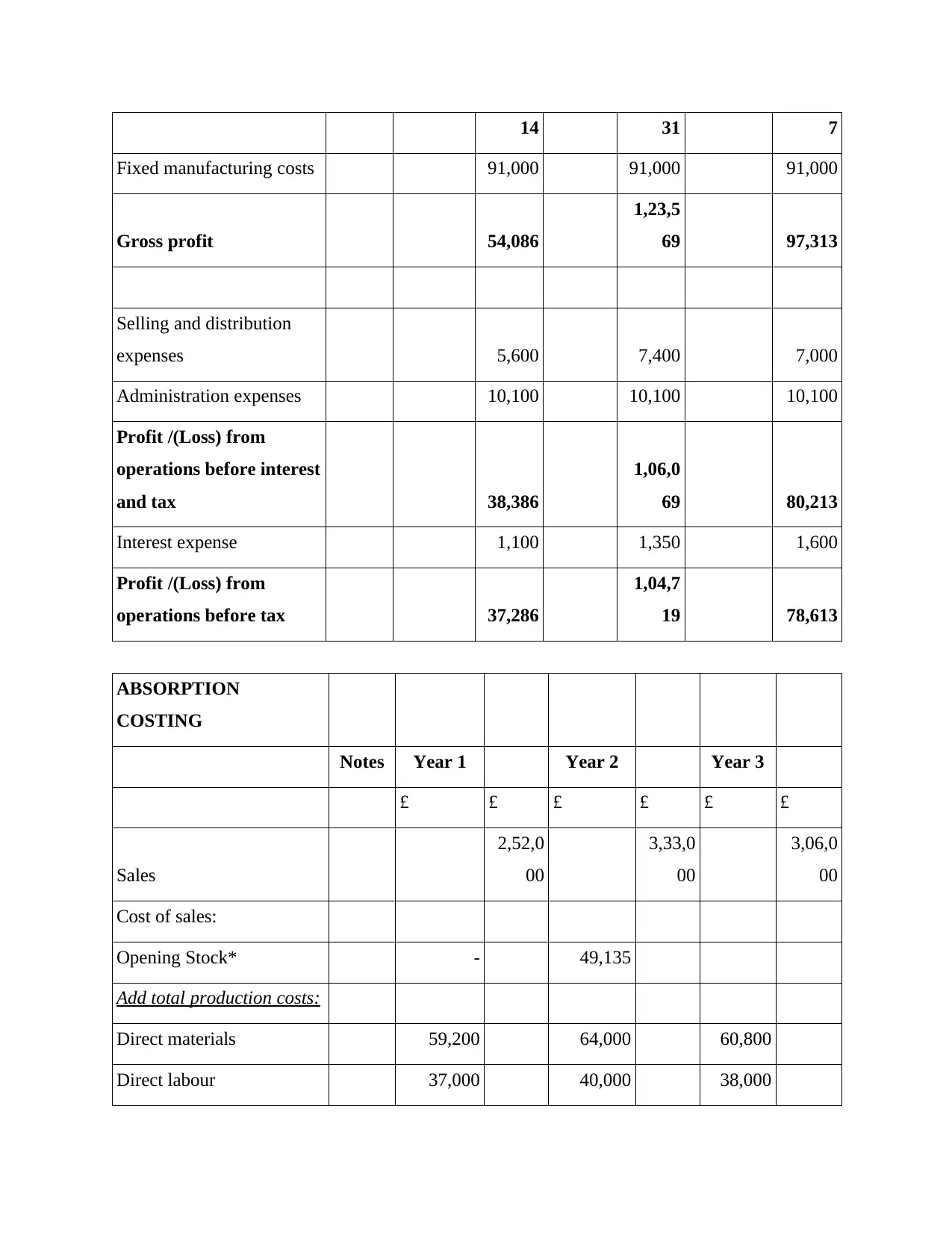
14 31 7
Fixed manufacturing costs 91,000 91,000 91,000
Gross profit 54,086
1,23,5
69 97,313
Selling and distribution
expenses 5,600 7,400 7,000
Administration expenses 10,100 10,100 10,100
Profit /(Loss) from
operations before interest
and tax 38,386
1,06,0
69 80,213
Interest expense 1,100 1,350 1,600
Profit /(Loss) from
operations before tax 37,286
1,04,7
19 78,613
ABSORPTION
COSTING
Notes Year 1 Year 2 Year 3
£ £ £ £ £ £
Sales
2,52,0
00
3,33,0
00
3,06,0
00
Cost of sales:
Opening Stock* - 49,135
Add total production costs:
Direct materials 59,200 64,000 60,800
Direct labour 37,000 40,000 38,000
Fixed manufacturing costs 91,000 91,000 91,000
Gross profit 54,086
1,23,5
69 97,313
Selling and distribution
expenses 5,600 7,400 7,000
Administration expenses 10,100 10,100 10,100
Profit /(Loss) from
operations before interest
and tax 38,386
1,06,0
69 80,213
Interest expense 1,100 1,350 1,600
Profit /(Loss) from
operations before tax 37,286
1,04,7
19 78,613
ABSORPTION
COSTING
Notes Year 1 Year 2 Year 3
£ £ £ £ £ £
Sales
2,52,0
00
3,33,0
00
3,06,0
00
Cost of sales:
Opening Stock* - 49,135
Add total production costs:
Direct materials 59,200 64,000 60,800
Direct labour 37,000 40,000 38,000
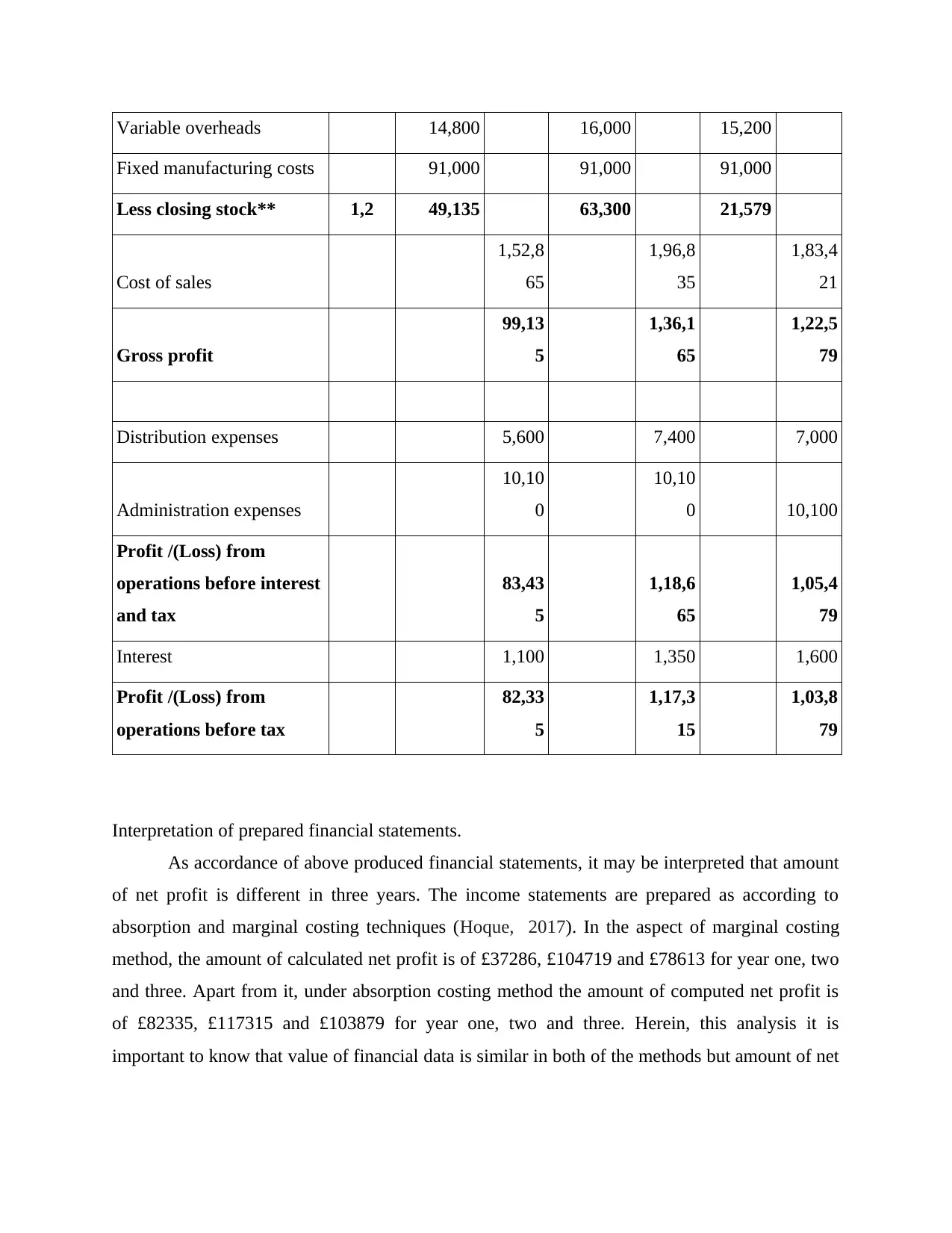
Variable overheads 14,800 16,000 15,200
Fixed manufacturing costs 91,000 91,000 91,000
Less closing stock** 1,2 49,135 63,300 21,579
Cost of sales
1,52,8
65
1,96,8
35
1,83,4
21
Gross profit
99,13
5
1,36,1
65
1,22,5
79
Distribution expenses 5,600 7,400 7,000
Administration expenses
10,10
0
10,10
0 10,100
Profit /(Loss) from
operations before interest
and tax
83,43
5
1,18,6
65
1,05,4
79
Interest 1,100 1,350 1,600
Profit /(Loss) from
operations before tax
82,33
5
1,17,3
15
1,03,8
79
Interpretation of prepared financial statements.
As accordance of above produced financial statements, it may be interpreted that amount
of net profit is different in three years. The income statements are prepared as according to
absorption and marginal costing techniques (Hoque, 2017). In the aspect of marginal costing
method, the amount of calculated net profit is of £37286, £104719 and £78613 for year one, two
and three. Apart from it, under absorption costing method the amount of computed net profit is
of £82335, £117315 and £103879 for year one, two and three. Herein, this analysis it is
important to know that value of financial data is similar in both of the methods but amount of net
Fixed manufacturing costs 91,000 91,000 91,000
Less closing stock** 1,2 49,135 63,300 21,579
Cost of sales
1,52,8
65
1,96,8
35
1,83,4
21
Gross profit
99,13
5
1,36,1
65
1,22,5
79
Distribution expenses 5,600 7,400 7,000
Administration expenses
10,10
0
10,10
0 10,100
Profit /(Loss) from
operations before interest
and tax
83,43
5
1,18,6
65
1,05,4
79
Interest 1,100 1,350 1,600
Profit /(Loss) from
operations before tax
82,33
5
1,17,3
15
1,03,8
79
Interpretation of prepared financial statements.
As accordance of above produced financial statements, it may be interpreted that amount
of net profit is different in three years. The income statements are prepared as according to
absorption and marginal costing techniques (Hoque, 2017). In the aspect of marginal costing
method, the amount of calculated net profit is of £37286, £104719 and £78613 for year one, two
and three. Apart from it, under absorption costing method the amount of computed net profit is
of £82335, £117315 and £103879 for year one, two and three. Herein, this analysis it is
important to know that value of financial data is similar in both of the methods but amount of net
⊘ This is a preview!⊘
Do you want full access?
Subscribe today to unlock all pages.

Trusted by 1+ million students worldwide
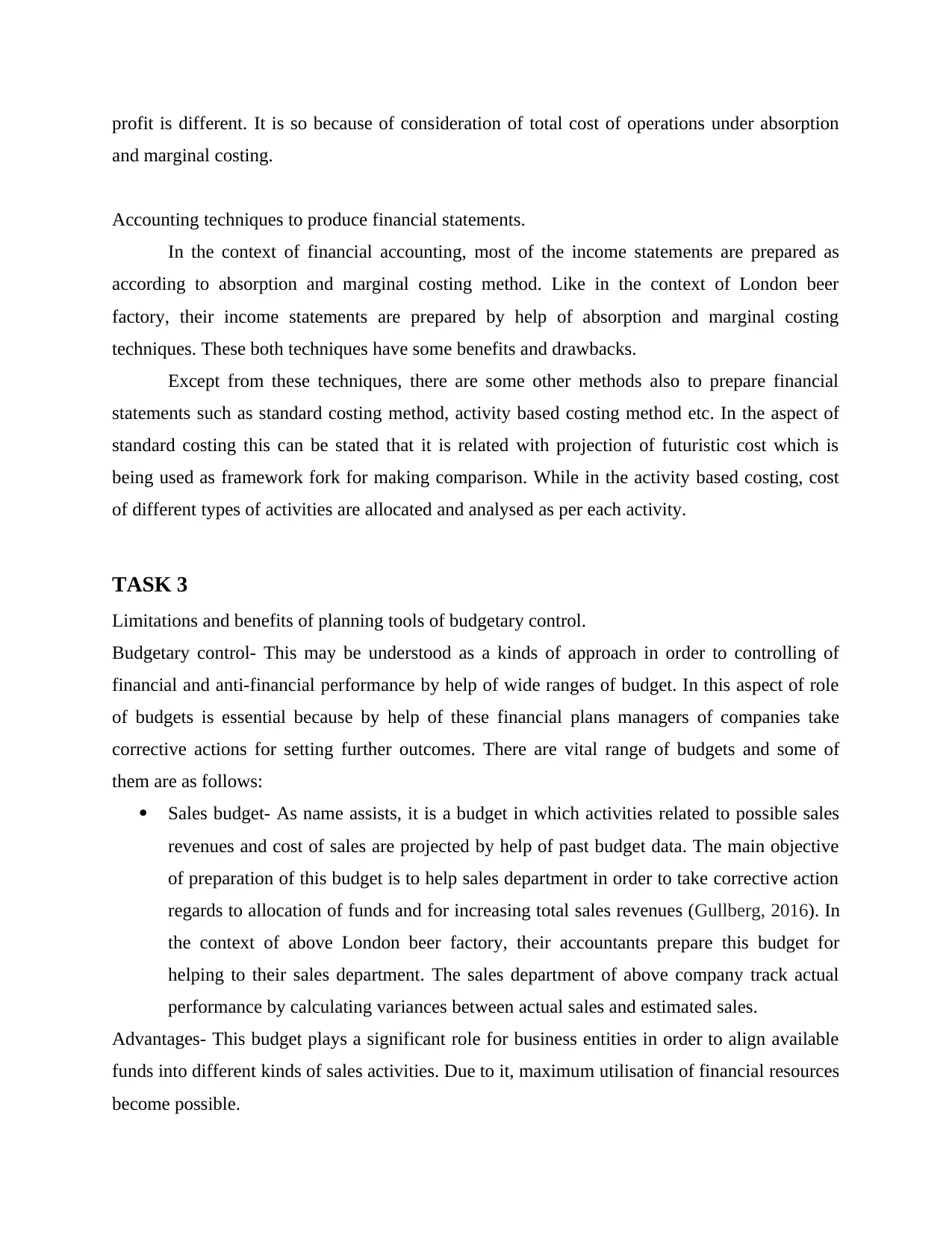
profit is different. It is so because of consideration of total cost of operations under absorption
and marginal costing.
Accounting techniques to produce financial statements.
In the context of financial accounting, most of the income statements are prepared as
according to absorption and marginal costing method. Like in the context of London beer
factory, their income statements are prepared by help of absorption and marginal costing
techniques. These both techniques have some benefits and drawbacks.
Except from these techniques, there are some other methods also to prepare financial
statements such as standard costing method, activity based costing method etc. In the aspect of
standard costing this can be stated that it is related with projection of futuristic cost which is
being used as framework fork for making comparison. While in the activity based costing, cost
of different types of activities are allocated and analysed as per each activity.
TASK 3
Limitations and benefits of planning tools of budgetary control.
Budgetary control- This may be understood as a kinds of approach in order to controlling of
financial and anti-financial performance by help of wide ranges of budget. In this aspect of role
of budgets is essential because by help of these financial plans managers of companies take
corrective actions for setting further outcomes. There are vital range of budgets and some of
them are as follows:
Sales budget- As name assists, it is a budget in which activities related to possible sales
revenues and cost of sales are projected by help of past budget data. The main objective
of preparation of this budget is to help sales department in order to take corrective action
regards to allocation of funds and for increasing total sales revenues (Gullberg, 2016). In
the context of above London beer factory, their accountants prepare this budget for
helping to their sales department. The sales department of above company track actual
performance by calculating variances between actual sales and estimated sales.
Advantages- This budget plays a significant role for business entities in order to align available
funds into different kinds of sales activities. Due to it, maximum utilisation of financial resources
become possible.
and marginal costing.
Accounting techniques to produce financial statements.
In the context of financial accounting, most of the income statements are prepared as
according to absorption and marginal costing method. Like in the context of London beer
factory, their income statements are prepared by help of absorption and marginal costing
techniques. These both techniques have some benefits and drawbacks.
Except from these techniques, there are some other methods also to prepare financial
statements such as standard costing method, activity based costing method etc. In the aspect of
standard costing this can be stated that it is related with projection of futuristic cost which is
being used as framework fork for making comparison. While in the activity based costing, cost
of different types of activities are allocated and analysed as per each activity.
TASK 3
Limitations and benefits of planning tools of budgetary control.
Budgetary control- This may be understood as a kinds of approach in order to controlling of
financial and anti-financial performance by help of wide ranges of budget. In this aspect of role
of budgets is essential because by help of these financial plans managers of companies take
corrective actions for setting further outcomes. There are vital range of budgets and some of
them are as follows:
Sales budget- As name assists, it is a budget in which activities related to possible sales
revenues and cost of sales are projected by help of past budget data. The main objective
of preparation of this budget is to help sales department in order to take corrective action
regards to allocation of funds and for increasing total sales revenues (Gullberg, 2016). In
the context of above London beer factory, their accountants prepare this budget for
helping to their sales department. The sales department of above company track actual
performance by calculating variances between actual sales and estimated sales.
Advantages- This budget plays a significant role for business entities in order to align available
funds into different kinds of sales activities. Due to it, maximum utilisation of financial resources
become possible.
Paraphrase This Document
Need a fresh take? Get an instant paraphrase of this document with our AI Paraphraser
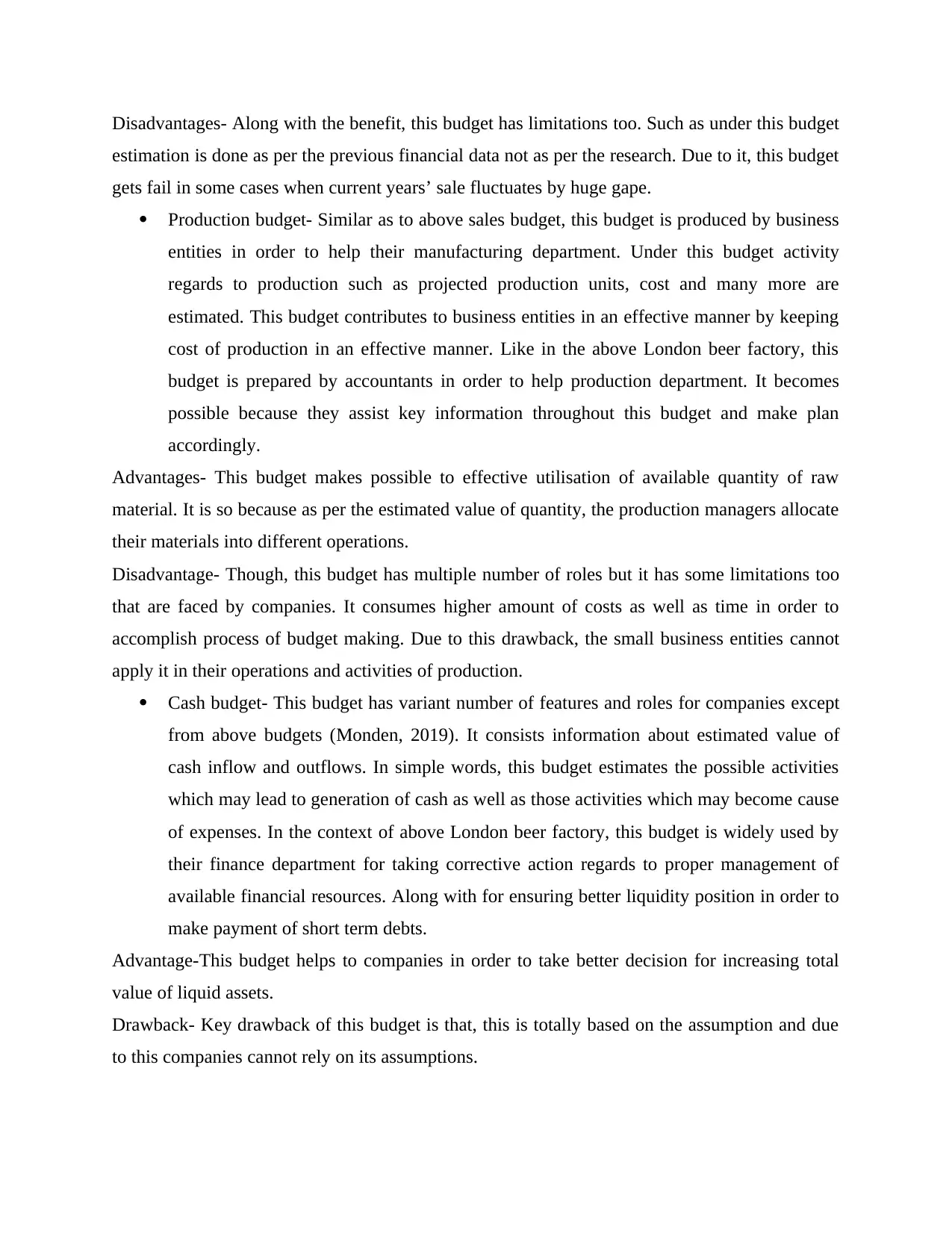
Disadvantages- Along with the benefit, this budget has limitations too. Such as under this budget
estimation is done as per the previous financial data not as per the research. Due to it, this budget
gets fail in some cases when current years’ sale fluctuates by huge gape.
Production budget- Similar as to above sales budget, this budget is produced by business
entities in order to help their manufacturing department. Under this budget activity
regards to production such as projected production units, cost and many more are
estimated. This budget contributes to business entities in an effective manner by keeping
cost of production in an effective manner. Like in the above London beer factory, this
budget is prepared by accountants in order to help production department. It becomes
possible because they assist key information throughout this budget and make plan
accordingly.
Advantages- This budget makes possible to effective utilisation of available quantity of raw
material. It is so because as per the estimated value of quantity, the production managers allocate
their materials into different operations.
Disadvantage- Though, this budget has multiple number of roles but it has some limitations too
that are faced by companies. It consumes higher amount of costs as well as time in order to
accomplish process of budget making. Due to this drawback, the small business entities cannot
apply it in their operations and activities of production.
Cash budget- This budget has variant number of features and roles for companies except
from above budgets (Monden, 2019). It consists information about estimated value of
cash inflow and outflows. In simple words, this budget estimates the possible activities
which may lead to generation of cash as well as those activities which may become cause
of expenses. In the context of above London beer factory, this budget is widely used by
their finance department for taking corrective action regards to proper management of
available financial resources. Along with for ensuring better liquidity position in order to
make payment of short term debts.
Advantage-This budget helps to companies in order to take better decision for increasing total
value of liquid assets.
Drawback- Key drawback of this budget is that, this is totally based on the assumption and due
to this companies cannot rely on its assumptions.
estimation is done as per the previous financial data not as per the research. Due to it, this budget
gets fail in some cases when current years’ sale fluctuates by huge gape.
Production budget- Similar as to above sales budget, this budget is produced by business
entities in order to help their manufacturing department. Under this budget activity
regards to production such as projected production units, cost and many more are
estimated. This budget contributes to business entities in an effective manner by keeping
cost of production in an effective manner. Like in the above London beer factory, this
budget is prepared by accountants in order to help production department. It becomes
possible because they assist key information throughout this budget and make plan
accordingly.
Advantages- This budget makes possible to effective utilisation of available quantity of raw
material. It is so because as per the estimated value of quantity, the production managers allocate
their materials into different operations.
Disadvantage- Though, this budget has multiple number of roles but it has some limitations too
that are faced by companies. It consumes higher amount of costs as well as time in order to
accomplish process of budget making. Due to this drawback, the small business entities cannot
apply it in their operations and activities of production.
Cash budget- This budget has variant number of features and roles for companies except
from above budgets (Monden, 2019). It consists information about estimated value of
cash inflow and outflows. In simple words, this budget estimates the possible activities
which may lead to generation of cash as well as those activities which may become cause
of expenses. In the context of above London beer factory, this budget is widely used by
their finance department for taking corrective action regards to proper management of
available financial resources. Along with for ensuring better liquidity position in order to
make payment of short term debts.
Advantage-This budget helps to companies in order to take better decision for increasing total
value of liquid assets.
Drawback- Key drawback of this budget is that, this is totally based on the assumption and due
to this companies cannot rely on its assumptions.
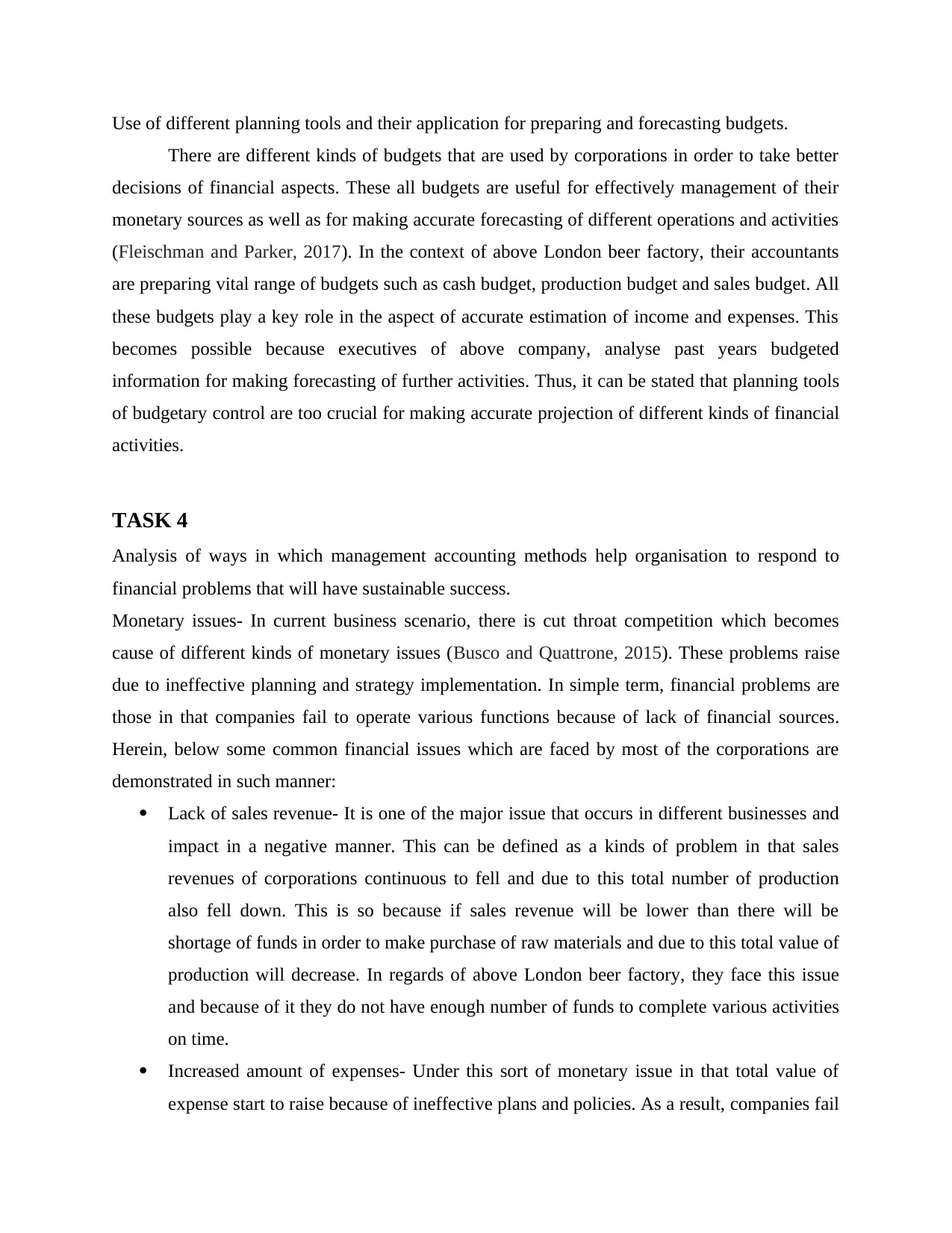
Use of different planning tools and their application for preparing and forecasting budgets.
There are different kinds of budgets that are used by corporations in order to take better
decisions of financial aspects. These all budgets are useful for effectively management of their
monetary sources as well as for making accurate forecasting of different operations and activities
(Fleischman and Parker, 2017). In the context of above London beer factory, their accountants
are preparing vital range of budgets such as cash budget, production budget and sales budget. All
these budgets play a key role in the aspect of accurate estimation of income and expenses. This
becomes possible because executives of above company, analyse past years budgeted
information for making forecasting of further activities. Thus, it can be stated that planning tools
of budgetary control are too crucial for making accurate projection of different kinds of financial
activities.
TASK 4
Analysis of ways in which management accounting methods help organisation to respond to
financial problems that will have sustainable success.
Monetary issues- In current business scenario, there is cut throat competition which becomes
cause of different kinds of monetary issues (Busco and Quattrone, 2015). These problems raise
due to ineffective planning and strategy implementation. In simple term, financial problems are
those in that companies fail to operate various functions because of lack of financial sources.
Herein, below some common financial issues which are faced by most of the corporations are
demonstrated in such manner:
Lack of sales revenue- It is one of the major issue that occurs in different businesses and
impact in a negative manner. This can be defined as a kinds of problem in that sales
revenues of corporations continuous to fell and due to this total number of production
also fell down. This is so because if sales revenue will be lower than there will be
shortage of funds in order to make purchase of raw materials and due to this total value of
production will decrease. In regards of above London beer factory, they face this issue
and because of it they do not have enough number of funds to complete various activities
on time.
Increased amount of expenses- Under this sort of monetary issue in that total value of
expense start to raise because of ineffective plans and policies. As a result, companies fail
There are different kinds of budgets that are used by corporations in order to take better
decisions of financial aspects. These all budgets are useful for effectively management of their
monetary sources as well as for making accurate forecasting of different operations and activities
(Fleischman and Parker, 2017). In the context of above London beer factory, their accountants
are preparing vital range of budgets such as cash budget, production budget and sales budget. All
these budgets play a key role in the aspect of accurate estimation of income and expenses. This
becomes possible because executives of above company, analyse past years budgeted
information for making forecasting of further activities. Thus, it can be stated that planning tools
of budgetary control are too crucial for making accurate projection of different kinds of financial
activities.
TASK 4
Analysis of ways in which management accounting methods help organisation to respond to
financial problems that will have sustainable success.
Monetary issues- In current business scenario, there is cut throat competition which becomes
cause of different kinds of monetary issues (Busco and Quattrone, 2015). These problems raise
due to ineffective planning and strategy implementation. In simple term, financial problems are
those in that companies fail to operate various functions because of lack of financial sources.
Herein, below some common financial issues which are faced by most of the corporations are
demonstrated in such manner:
Lack of sales revenue- It is one of the major issue that occurs in different businesses and
impact in a negative manner. This can be defined as a kinds of problem in that sales
revenues of corporations continuous to fell and due to this total number of production
also fell down. This is so because if sales revenue will be lower than there will be
shortage of funds in order to make purchase of raw materials and due to this total value of
production will decrease. In regards of above London beer factory, they face this issue
and because of it they do not have enough number of funds to complete various activities
on time.
Increased amount of expenses- Under this sort of monetary issue in that total value of
expense start to raise because of ineffective plans and policies. As a result, companies fail
⊘ This is a preview!⊘
Do you want full access?
Subscribe today to unlock all pages.

Trusted by 1+ million students worldwide
1 out of 16
Related Documents
Your All-in-One AI-Powered Toolkit for Academic Success.
+13062052269
info@desklib.com
Available 24*7 on WhatsApp / Email
![[object Object]](/_next/static/media/star-bottom.7253800d.svg)
Unlock your academic potential
Copyright © 2020–2025 A2Z Services. All Rights Reserved. Developed and managed by ZUCOL.





